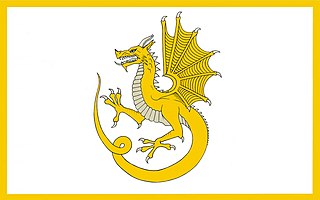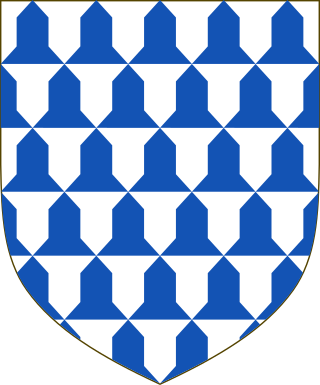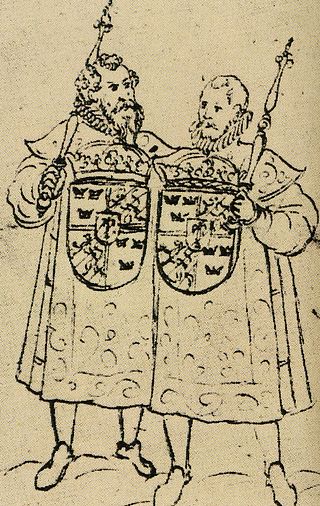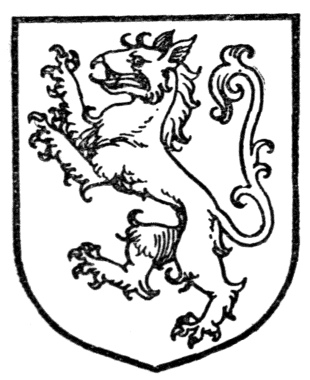
Heraldry is a discipline relating to the design, display and study of armorial bearings, as well as related disciplines, such as vexillology, together with the study of ceremony, rank and pedigree. Armory, the best-known branch of heraldry, concerns the design and transmission of the heraldic achievement. The achievement, or armorial bearings usually includes a coat of arms on a shield, helmet and crest, together with any accompanying devices, such as supporters, badges, heraldic banners and mottoes.

A coat of arms is a heraldic visual design on an escutcheon, surcoat, or tabard. The coat of arms on an escutcheon forms the central element of the full heraldic achievement, which in its whole consists of a shield, supporters, a crest, and a motto. A coat of arms is traditionally unique to the armiger. The term 'coat of arms' itself, describing in modern times just the heraldic design, originates from the description of the entire medieval chainmail 'surcoat' garment used in combat or preparation for the latter.
In heraldry, tenné is a "stain", or non-standard tincture, of orange, light brown or orange-tawny colour.

The wyvern is a type of mythical dragon with two legs, two wings, and often a pointed tail which is said to be a venomous stinger.

Tincture is the limited palette of colours and patterns used in heraldry. The need to define, depict, and correctly blazon the various tinctures is one of the most important aspects of heraldic art and design.

In heraldry, an armiger is a person entitled to use a heraldic achievement either by hereditary right, grant, matriculation, or assumption of arms. Such a person is said to be armigerous; a family or a clan likewise.

Vair, originating as a processed form of squirrel fur, gave its name to a set of different patterns used in heraldry. Heraldic vair represents a kind of fur common in the Middle Ages, made from pieces of the greyish-blue backs of squirrels sewn together with pieces of the animals' white underbellies. Vair is the second-most common fur in heraldry, after ermine.

Swedish heraldry encompasses heraldic achievements in modern and historic Sweden. Swedish heraldic style is consistent with the German-Nordic heraldic tradition, noted for its multiple helmets and crests which are treated as inseparable from the shield, its repetition of colours and charges between the shield and the crest, and its scant use of heraldic furs. Because the medieval history of the Nordic countries was so closely related, their heraldic individuality developed rather late. Swedish and Finnish heraldry have a shared history prior to the Diet of Porvoo in 1809; these, together with Danish heraldry, were heavily influenced by German heraldry. Unlike the highly stylized and macaronic language of English blazon, Swedish heraldry is described in plain language, using only Swedish terminology.

The enfield is a fictitious creature sometimes used in heraldry.

Due to the differing role of women in past society, special rules grew relating to the blazoning of arms for women. The rules for women and heraldry developed differently from place to place and there is no one single rule that applies everywhere. In general, arms of women were most likely depicted not on shields but on lozenges or ovals. Different rules exist that depend on the woman's marital status and a married woman would also often make use of her husband's arms in addition to those from her family. In both the English and the Scottish systems of heraldry these differences remain active.
In British heraldry, vert is the tincture equivalent to green. It is one of the five dark tinctures called colours.

The lion is a common charge in heraldry. It traditionally symbolises courage, nobility, royalty, strength, stateliness and valour, because historically the lion has been regarded as the "king of beasts". The lion also carries Judeo-Christian symbolism. The Lion of Judah stands in the coat of arms of Jerusalem. Similar-looking lions can be found elsewhere, such as in the coat of arms of the Swedish royal House of Bjelbo, from there in turn derived into the coat of arms of Finland, formerly belonging to Sweden.

Ecclesiastical heraldry refers to the use of heraldry within Christianity for dioceses, organisations and Christian clergy. Initially used to mark documents, ecclesiastical heraldry evolved as a system for identifying people and dioceses. It is most formalized within the Catholic Church, where most bishops, including the Pope, have a personal coat of arms. Clergy in Anglican, Lutheran, Eastern Catholic and Eastern Orthodox churches follow similar customs, as do institutions such as schools and dioceses.

A crown is often an emblem of a sovereign state, usually a monarchy, but also used by some republics.

In heraldry and heraldic vexillology, a blazon is a formal description of a coat of arms, flag or similar emblem, from which the reader can reconstruct the appropriate image. The verb to blazon means to create such a description. The visual depiction of a coat of arms or flag has traditionally had considerable latitude in design, but a verbal blazon specifies the essentially distinctive elements. A coat of arms or flag is therefore primarily defined not by a picture but rather by the wording of its blazon. Blazon is also the specialized language in which a blazon is written, and, as a verb, the act of writing such a description. Blazonry is the art, craft or practice of creating a blazon. The language employed in blazonry has its own vocabulary, grammar and syntax, which becomes essential for comprehension when blazoning a complex coat of arms.

In heraldry and vexillology, a heraldic flag is a flag containing coats of arms, heraldic badges, or other devices used for personal identification.

The wolf has been widely used in many forms in heraldry during the Middle Ages. Though commonly reviled as a livestock predator and man-eater, the wolf was also considered a noble and courageous animal, and frequently appeared on the arms and crests of numerous noble families. It typically symbolised the rewards of perseverance in long sieges or hard industry.

In heraldry, the term attitude describes the position in which a figure is emblazoned as a charge, a supporter, or as a crest. The attitude of a heraldic figure always precedes any reference to the tincture of the figure and its parts. Some attitudes apply only to predatory beasts, exemplified by the beast most usual to heraldry – the heraldic lion; other terms apply to docile animals, such as the doe, usually emblazoned as a "hind".

English heraldry is the form of coats of arms and other heraldic bearings and insignia used in England. It lies within the so-called Gallo-British tradition. Coats of arms in England are regulated and granted to individuals by the English kings of arms of the College of Arms. An individual's arms may also be borne 'by courtesy' by members of the holder's nuclear family, subject to a system of cadency marks, to differentiate those displays from the arms of the original holder. The English heraldic style is exemplified in the arms of British royalty, and is reflected in the civic arms of cities and towns, as well as the noble arms of individuals in England. Royal orders in England, such as the Order of the Garter, also maintain notable heraldic bearings.

Tyger, also known as heraldic tiger or tygre, is an imaginary beast used as a charge in heraldry.














